Unlike the mill workers in the previous post, these two seamstresses appear to be posing outdoors, perhaps at a seasonal or mobile studio. The photographer, Håkon Steinsheim (1860-1933), was based in the village of Oppdal, Norway. (Historically, the name of the town was sometimes spelled Opdal.)

The photo (cabinet card) came to me from Wisconsin.
The seamstress on the left appears to be working on a corset, with discarded stays (boning) lying on the ground next to her.

I’m not sure what the other young woman is working on. Maybe a blouse or a dress? Near the bottom of the print is a small area of image loss.

The sewing machines are a type I haven’t seen before. If you know anything about them, please leave a comment. Thinking again about the mill workers in the previous post, I’m struck by how different this depiction of working women is from that one, even though they may have been made around the same time, or only a few years apart.

Update, March 17: In 2016 the National Library of Norway published a book of Håkon Steinsheim’s photographs: Steinsheim in the spotlight: 220 photos from a unique photo collection. You can browse the entire book on the Library’s website. On page 91 is another portrait of the young woman on the left above. She was Sigrid Haldosdatter Kolstad (1874-1955), a seamstress who lived in the nearby hamlet of Rise.

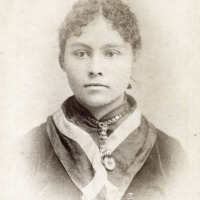
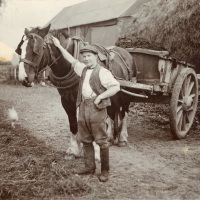
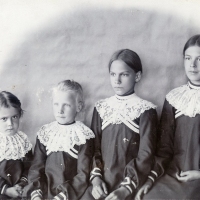
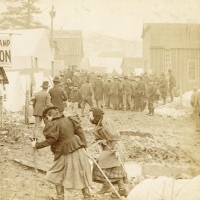
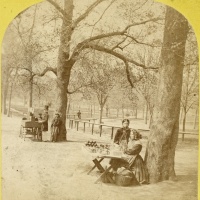
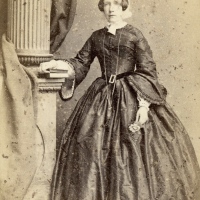
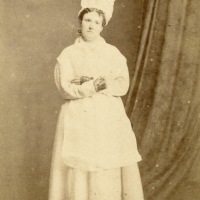
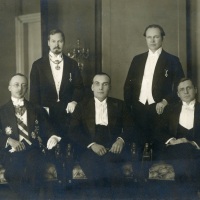
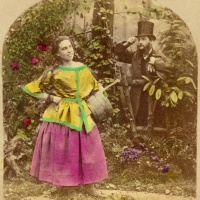
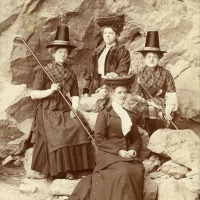
Nice portraits anyway. The detail of the discarded stays is quite interesting.
LikeLiked by 4 people
Thank you! I agree about the stays. It’s strange that they’re on the ground, because they look perfectly usable.
LikeLiked by 1 person
The first thing I noticed is that the women are smiling. That they are posed outdoors seems unusual. Maybe they are working at home? I’ve never seen a sewing machine like that. There are no treadles underneath the table so I wonder about that as well.
One of my grandmothers worked in a garment factory in the early 20s. She was so good at seams she was promoted to sleeves. 🙂
LikeLiked by 4 people
I thought the outdoor setting was unusual as well.
LikeLiked by 2 people
Yes, their amused expressions are fun to see. The setting is rather mysterious. I can’t imagine why a studio would have a dirt floor, unless it was meant to be temporary. I suspect this one was only used in the summer months.
That’s neat about your grandmother! 💜
LikeLiked by 1 person
Wonderful photo! I really like their “work wear” – perhaps it’s even colorful, what do you think? About the sewing machines – these seem a bit different from the regular Singer and Husqvarna machines that were common back then. My granny had a beautiful one from Husqvarna – black and gold, with the big sewing wheel. Maybe you can find something on this site (many pics): https://www.catawiki.se/stories/4935-hur-du-bestammer-vardet-pa-din-gamla-symaskin
LikeLiked by 3 people
I thought the sewing machines looked like ones that were cranked by hand. As someone with a lot of sewing experience, I can say that sewing a straight seam using only one hand takes a great deal of skill. (I need both of my hands to do it!)
LikeLiked by 6 people
Yes, they do look like that! The one I have left from granny is an old one like that, but it’s been modified sometime during the mid 1900s with a small lamp (to see what you’re sewing) and a pedal. Don’t know if that was common, but it must have made it easier to accomplish those straight seams 😁.
LikeLiked by 2 people
I concur, Liz!
LikeLiked by 2 people
Thérèse and Liz, after reading your comments, I realized that the woman on the left must have her hand on a handle which turned the wheel of the machine. Her fingers definitely appear to be holding something. Thérèse, thank you for the link!
LikeLiked by 1 person
It’s a beautiful photo!
LikeLiked by 1 person
Thank you! I wish I knew how it came to be in Wisconsin.
LikeLiked by 1 person
Perhaps sent to relatives?
LikeLiked by 1 person
Yes, or brought by immigrants from Norway. I’d love to know the details.
LikeLike
It is a lovely photo, they look peaceful and happy.
LikeLiked by 1 person
Maybe because they aren’t toiling in a factory! 😉
LikeLiked by 2 people
Is it possible the photo was taken in an indoor space with a dirt floor?
Intriguing photo, including the discarded stays. One wonders why they would be discarded/wasted?
The attire – aprons? – of the seamstresses are beautiful in their vibrancy – flowers, and stripes. The woman on the right has a measuring tape around her neck; normal for her, or a prop for the photo? Are the stays on the ground props as well?
LikeLiked by 3 people
Yes, it does appear to be an indoor space with a dirt floor. To my mind, that only makes sense if it was used on a temporary basis. Oppdal is in the mountains. It’s not a very big place. (Today it’s known as a ski town.) I suspect Mr. Steinsheim operated temporary studios in other towns during the warmer months of the year, when travel was easiest.
This morning I discovered that the National Library of Norway published a book of Håkon Steinsheim’s photos in 2016. It’s browsable online, but it’s in Norwegian. I’ll add a link to the post.
Everything in this photo looks staged to some degree. I have no idea why the stays are on the ground, since they look perfectly usable. Steinsheim may actually have hired the women to pose, although that wouldn’t necessarily make the photo less authentic.
LikeLiked by 4 people
Another great photo, Brad. I wonder if the stays fell off her lap, since there doesn’t seem (haha) to be room on that little sewing table. Her apron is fabulous.
LikeLiked by 3 people
That table is way too small for them, haha! Can you tell what the other woman is working on? It looks sort of like an apron….
The day after publishing this post, I realized I had forgotten to look for photos by Steinsheim on Flickr. Photos there often don’t come up in Google searches. Lo and behold, there were several, including one which mentioned his first name in the description (Håkon). Once I was able to Google his full name, I found the book of his photos that was published in 2016, which contained another portrait of the woman on the left. I ended up having to rewrite most of this post. Oh well, better late than never, I suppose.
LikeLiked by 3 people
We appreciate all your hard work Brad! Another fascinating post. This beautifully staged photograph has a real documentary feel about it doesn’t it? I’m going to look at Steinsheim’s other works now, thanks for the link. I imagine he travelled Norway looking to capture everyday life and persuaded these women to pose for him. For me its charm lies in capturing the beauty in everyday occupations.
LikeLiked by 2 people
Researching photos is too fun to qualify as work, but thank you, Louise! Like you, Steinsheim must have recognized the beauty of traditional occupations. The book contains a number of occupational images, including two with sewing machines (p. 75). He also seems to have spent a great deal of time outside of his studio. One chapter of the book is titled “På reisefot” (On the road). What a wonderful body of work he created for his community. It’s so fortunate that the negatives were preserved (at the family farm).
LikeLike
Not enough light in the place of business perhaps? Maybe they moved this into a spot where the light was more favourable.
LikeLiked by 1 person
That could be! Indoor spaces generally didn’t have enough light for photography in the 1890s.
LikeLike
Oh, I love everything about this photo – their aprons, the fabric, the sewing machine – this one is really lovely!
LikeLiked by 1 person
That’s very sweet of you to say, thank you so much!
LikeLike
I have seen such sewing machines, and not in a museum either! It looks like one of the women is turning the wheel with a crank handle, but I have seen them used by giving the wheel a powerful push and sew while it’s got the momentum. The wheel is heavy and would go for quite a bit.
In 1999 I visited Dubai and went into a tailor’s, run by immigrants from Pakistan. There was a manager, and three or four tailors, squatting on the floor in front of just such sewing machines – no treadles, no electricity. They were amazingly skilful as well. You could go in there with a picture from a magazine with, say, Sandra Bullock’s Oscars red carpet dress, and tell them “make me a dress like that”. You would have to provide the fabric (no problem, plenty of fabric shops in the neighbourhood), and they would do it.
LikeLiked by 1 person
That’s a great story! Isn’t it interesting that machines from earlier eras are still used in some parts of the world. It makes sense, even if they require a bit more effort.
By the way, the Abingdon blog is really good! I probably won’t leave any comments there, unless I have something pertinent to say, but you’re doing a great job with it!
LikeLike
Thank you, I was wondering if you were one of our readers! We’ll go back to a slower pace on it after this month, but we’ll certainly keep it going.
LikeLiked by 1 person
The two women have such sweet expressions. I can imagine them talking with one another as they tend to their sewing. I think the woman on the right might be working on an outer garment, a blouse or dress. It has buttons and a lining on the inside for stability. I would guess that she is working on the neckline of it, finishing up the details. I’m so glad you shared the back of the photo as well. They are so often a work of art in and of themselves! A lovely post Brad, thank you! ☺️
LikeLiked by 1 person
Ah, a neckline makes sense! It looks too small to be a waistline, but also quite heavy, which confused me. But dresses and blouses were heavier in those days, especially when made from wool. Thank you so much for your help and kind words! 😊
LikeLiked by 1 person
Très belles photos … j’aime voir le dé au doigt de la couturière . Les machines à coudre peuvent être des machines à manivelle . Ce lien vers des modèles où on retrouve le même genre de socle. http://bouton84.free.fr/page%20sur%20les%20dates.html
Merci pour ce partage . Joyeuses Fêtes de Pâques .
LikeLiked by 1 person
Hi Pierrette, I’m sure you’re right that these machines were cranked by hand. You found an excellent reference page! I found some other good pages with photos, but the page you found is the most complete. Also, you have a very good eye to notice the thimble on her finger! I didn’t pay enough attention and didn’t realize what it was.
Thank you so much and have a wonderful Easter! 💐
LikeLike
One of the advantages of falling behind in my reading is that I gain the benefit of others’ comments and your research! I did recognize the machines as hand-cranked. My grandmother had one, although by the time I came along she’d been blessed with one that ran on electricity: an old Singer, as I recall. I have seen machines with hand-cranks being used — in Monrovia, Liberia, of all places. In a place where electrical service could be erratic, they made a good backup.
I don’t know a thing about corset stays, but in the 1950s, my dad and his friends always wore shirts with collar stays. I know that from time to time they were replaced; you could buy extras in packages. Perhaps flexing or some other cause led to them losing their stiffness. If that’s so, corset stays probably had an even shorter life!
LikeLiked by 1 person
That’s interesting about the collar stays, Linda. It’s funny how things can be ubiquitous for a long time and then go out of fashion. For example, until roughly the 1940s, men almost always wore hats in public. I’m not sure exactly when they stopped–or why.
This must be one of the nicest times of year in Texas, with beautiful weather and so many flowers blooming. Spring is just beginning here in Vermont. We currently have one crocus blooming and a few daffodils. The birds have arrived in force, though, so the rest of nature won’t be far behind.
LikeLike
A lovely portrait that marked an era of inventions, of machines and people. The women look gorgeous. A very subtle yet powerful photograph! Thanks for sharing!
LikeLiked by 1 person
Thank you for your very kind words!
LikeLike
Keenly observed! The rustic photos capture a lot of enigmas and it is a fine hobby to notice such fine aspects. I loved reading it.
LikeLiked by 1 person
Thank you for your visit and nice comment!
LikeLike
👌👌👌📷
LikeLiked by 1 person